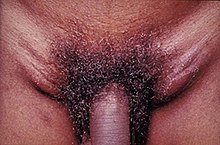
Back ورم حبيبي لمفي منقول جنسيا Arabic Limfogranuloma veneri Catalan Lymfogranuloma venereum Czech Lymphogranuloma venereum German Linfogranuloma venéreo Spanish لنفوگرانولوما ونروم Persian Lymphogranuloma venereum Finnish Lymphogranulome vénérien French Limfeagranalóma véinéireach Irish לימפוגרנולומה ונראום HE
| Lymphogranuloma venereum | |
|---|---|
 | |
| Lymphogranuloma venereum in a young adult who experienced acute onset of tender, enlarged lymph nodes in both groins | |
| Specialty | Infectious diseases |
Lymphogranuloma venereum (LGV; also known as climatic bubo,[1] Durand–Nicolas–Favre disease,[1] poradenitis inguinale,[1] lymphogranuloma inguinale, and strumous bubo)[1] is a sexually transmitted infection caused by the invasive serovars L1, L2, L2a, L2b, or L3 of Chlamydia trachomatis.[2]
LGV is primarily an infection of lymphatics and lymph nodes. Chlamydia trachomatis is the bacterium responsible for LGV. It gains entrance through breaks in the skin, or it can cross the epithelial cell layer of mucous membranes. The organism travels from the site of inoculation down the lymphatic channels to multiply within mononuclear phagocytes of the lymph nodes it passes.
In developed nations, it was considered rare before 2003.[3] An outbreak in the Netherlands among gay men has led to an increase of LGV in Europe and the United States.[4][5]
LGV was first described by Wallace in 1833[6] and again by Durand, Nicolas, and Favre in 1913.[7][8] Since the 2004 Dutch outbreak many additional cases have been reported, leading to greater surveillance.[9] Soon after the initial Dutch report, national and international health authorities launched warning initiatives and multiple LGV cases were identified in several more European countries (Belgium, France, the UK,[10] Germany, Sweden, Italy and Switzerland) and the US and Canada. All cases reported in Amsterdam and France and a considerable percentage of LGV infections in the UK and Germany were caused by a newly discovered Chlamydia variant, L2b, a.k.a. the Amsterdam variant. The L2b variant could be traced back and was isolated from anal swabs of men who have sex with men (MSM) who visited the STI city clinic of San Francisco in 1981. This finding suggests that the recent LGV outbreak among MSM in industrialised countries is a slowly evolving epidemic. The L2b serovar has also been identified in Australia.[11]
- ^ a b c d Rapini, Ronald P.; Bolognia, Jean L.; Jorizzo, Joseph L. (2007). Dermatology: 2-Volume Set. St. Louis: Mosby. ISBN 978-1-4160-2999-1.
- ^ Ward H, Martin I, MacDonald N, et al. (January 1, 2007). "Lymphogranuloma Venereum in the United Kingdom". Clinical Infectious Diseases. 44 (1). Infectious Diseases Society of America: 26–32. doi:10.1086/509922. ISSN 1058-4838. JSTOR 4485191. PMC 1764657. PMID 17143811.
- ^ Richardson D; Goldmeier D (January 2007). "Lymphogranuloma venereum: an emerging cause of proctitis in men who have sex with men". International Journal of STD & AIDS. 18 (1): 11–4, quiz 15. doi:10.1258/095646207779949916. PMID 17326855. S2CID 36269503.
- ^ Thomas H. Maugh II. Virulent Chlamydia Detected Largely Among Gay Men in U.S. Los Angeles Times: 11 May 2006
- ^ Michael Brown. LGV in the UK: almost 350 cases reported and still predominantly affecting HIV-positive gay men Aidsmap: 17 May 2006
- ^ Lymphogranuloma Venereum at eMedicine
- ^ synd/1431 at Who Named It?
- ^ Durand N.J.; Nicolas J.; Favre M. (January 1913). "Lymphogranulomatose inguinale subaiguë d'origine génitale probable, peut-être vénérienne". Bulletin de la Société des Médecins des Hôpitaux de Paris. 35: 274–288.
- ^ Kivi M; Koedijk FD; van der Sande M; van de Laar MJ (April 2008). "Evaluation prompting transition from enhanced to routine surveillance of lymphogranuloma venereum (LGV) in the Netherlands". Eurosurveillance. 13 (14): 7–8. doi:10.2807/ese.13.14.08087-en. PMID 18445453.
- ^ Jebbari H, Alexander S, Ward H, et al. (July 2007). "Update on lymphogranuloma venereum in the United Kingdom". Sexually Transmitted Infections. 83 (4): 324–6. doi:10.1136/sti.2007.026740. PMC 2598681. PMID 17591663.
- ^ Stark D; van Hal S; Hillman R; Harkness J; Marriott D (March 2007). "Lymphogranuloma venereum in Australia: anorectal Chlamydia trachomatis serovar L2b in men who have sex with men". Journal of Clinical Microbiology. 45 (3): 1029–31. doi:10.1128/JCM.02389-06. PMC 1829134. PMID 17251405.
© MMXXIII Rich X Search. We shall prevail. All rights reserved. Rich X Search